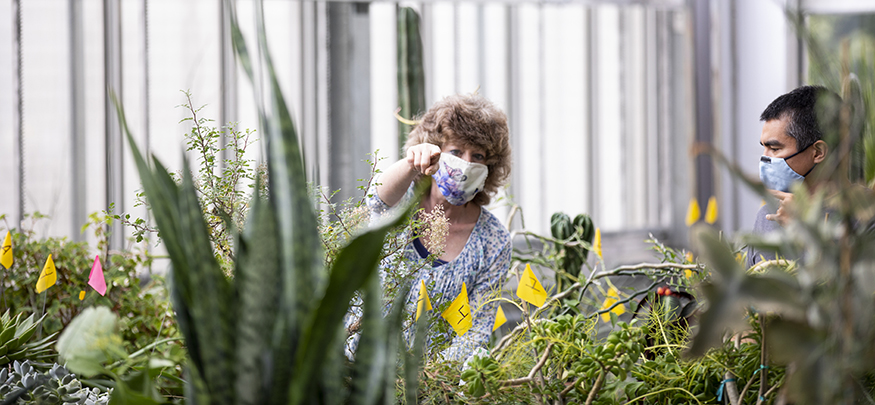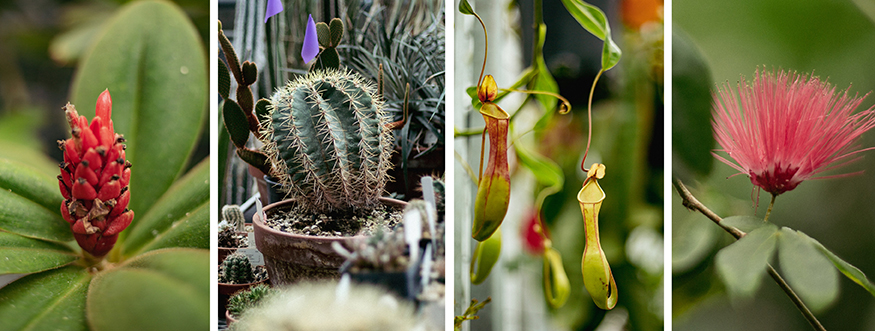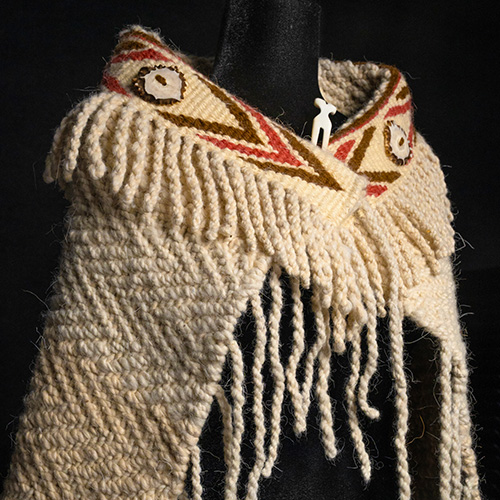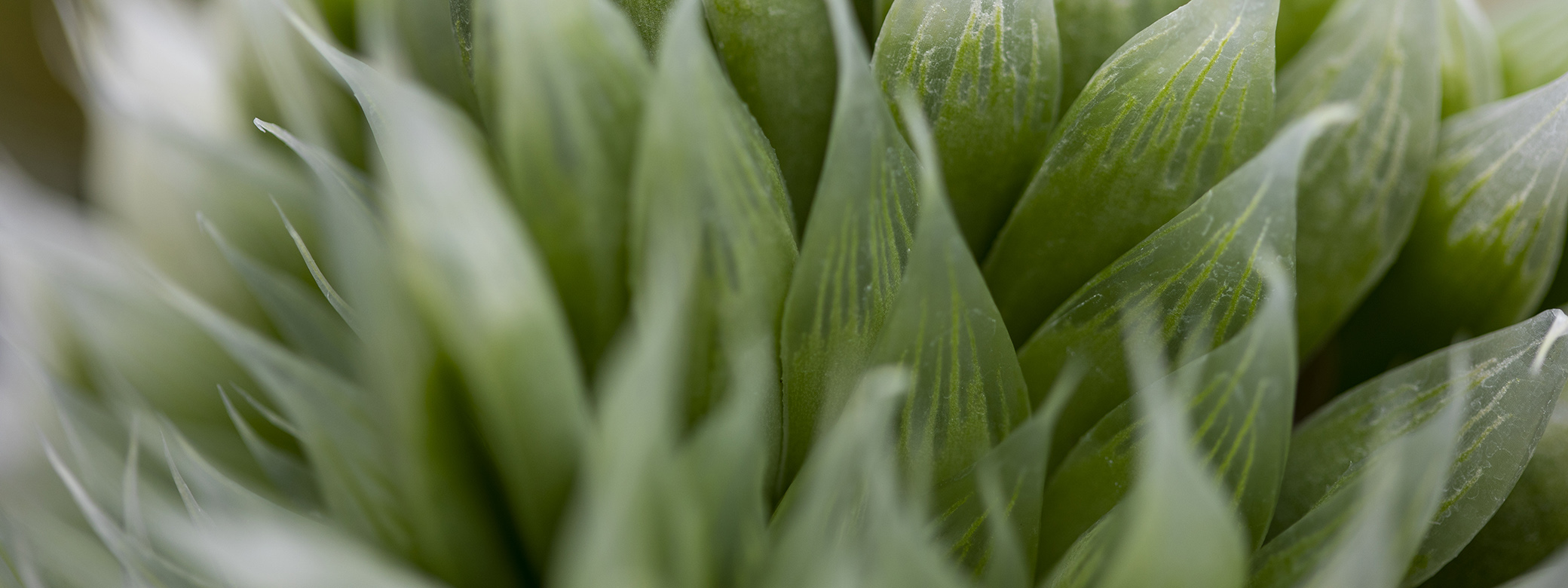
During a biology lab course held in the new UW Biology Greenhouse, Sara Stokes had an epiphany. A few weeks into the course, she was determined to become a greenhouse volunteer.
“I knew the greenhouse had to be a bigger part of my life,” says Stokes, a UW biology major with a minor in bioethics. “I absolutely fell in love with the wide diversity of plants on display and the incredible beauty of this reserve of nature, right on campus. I had to get closer.”
Greenhouse manager Katie Sadler says Stokes is not alone. Most greenhouse volunteers — there are currently 17 — discover the facility through a course or a tour and get hooked. They help greenhouse staff care for the plants, from watering to potting to plant hygiene. Joining them on the team are about a dozen docents, mostly graduate students, who lead greenhouse tours.
A few years ago, none of these opportunities were possible. The University’s previous greenhouse was dismantled in 2016, and until the new building opened in 2021, the plants lived in a temporary facility far from campus. For plant enthusiasts, it’s been a joy to see the new greenhouse flourish.
Nature, Assisted by Technology
Sadler explains that the original greenhouse, though beloved, had outlived its useful life span after 65 years. “It was falling apart,” she says. “It was literally held together with bailing wire in some instances. And the technology was becoming obsolete, though [then greenhouse manager] Doug Ewing did the very best with what he had. He was a true plant lover and very knowledgeable.”
Of course, Sadler is a devoted plant lover as well. Before coming to the UW, she managed greenhouse facilities at the University of Kansas for 29 years. But managing the UW collection was an opportunity she couldn’t pass up. “It was a dream come true to move out here and into a larger plant collection,” she says.

Sadler arrived in 2021, just six weeks before the plants were scheduled to move from their temporary home to the new facility. By her fifth day on the job, she was immersed in move logistics. “It was crazy,” she recalls. “It’s still insanely busy, actually. We’ve hit the ground running and we’ve been running ever since, but in a great way.”
The state-of-the-art greenhouse is attached to the new Life Sciences Building and borders the Burke Gilman trail. It houses more than 5,500 plants from diverse habitats, from Costa Rican rainforests to Pacific Northwest mountains to the Namib desert, where the two-leafed welwitschia on display can live up to 1,000 years. The facility is ADA-accessible, with state-of-the-art systems that control temperature and humidity. Foggers, shades, and lamps can be set to mimic specific growing environments.
“There’s also the option to water with the push of a button,” Sadler says, “but we hand-water the plants since they all have different watering needs.”
If I’m ever stressed about schoolwork, I can take a few hours off to be surrounded by plants and I’m right as rain.
The facility is 20,000 square feet, with nine greenhouse rooms. Several rooms are set up for research or teaching — both of which are central to the mission of the greenhouse. Students visit the greenhouse through classes ranging from plant ecology to art to engineering. The remaining rooms house the diverse plant collection.
Stokes’ favorite space is the “Tree of Life” room at the east end of the building, designed with guidance from museum studies graduate student Sihan Wang. Through explanatory signage and a chronological arrangement of plants, the room tells the story of plant evolution. It also highlights plants of economic importance, including citrus, cotton, tobacco, coffee, bananas, and black pepper. “It’s a striking diversity of plants in such close proximity,” Stokes says. “It’s truly awe-inspiring to see the history of nature unfold in front of you.”

Upcoming greenhouse projects include the training of docents to lead tours of the UW Medicinal Herb Garden, a 112-year-old garden not far from the building. Managed by Keith Possee as a greenhouse/landscape partnership, the 2.5 acre garden meanders near Stevens Way and features more than 1,000 species of plants used by contemporary medicine and in traditional Native American methods.
Welcoming the Public
Though the new greenhouse has been hosting biology lab classes and individual research projects since it opened, preparing for other visitors has taken longer. Last December, the facility finally opened to the general public, with regular visiting hours on Thursdays and Saturdays (see sidebar). At other times, docents lead greenhouse tours — currently free thanks to donor support — for larger groups. The response has been overwhelming, with hundreds of visitors each week and more than 65 tours booked over the most recent three-month period.

Biology graduate student Andrew Hempton has led about a dozen tours so far, for groups ranging from elementary school students to gardening clubs. “I enjoy sharing my love of plants and seeing the realization of the utter strangeness and uniqueness of plants dawning on folks who come in ‘plant blind,’” he says. “Besides, I wanted a good excuse to be hanging around the rooms, snooping on a daily basis.”
Hanging around greenhouses is nothing new for Hempton. During his years as a UW undergraduate (BS, Plant Biology, 2014), he worked in a faculty research lab that required regular visits to the former greenhouse. And while the new facility benefits from more space and new technology, he remembers the old building fondly. “The older greenhouse had the benefit of that ‘lived-in’ feel, built up over decades of use,” he says.
Given a little time, the new facility will likely take on its own lived-in personality. It’s already magical for Stokes, who swears by “plant therapy” visits as a way to de-stress.
“It’s meditative to be able to tune everything else out for a while and just focus on keeping the plants happy,” she says. “If I’m ever stressed about schoolwork, I can take a few hours off to be surrounded by plants and I’m right as rain.”
To cover the cost of docents who lead greenhouse tours, consider a gift to the Greenhouse Support Fund.
More Stories

A Healing Heart Returns
In February, the UW Symphony will perform a symphony that Coast Salish elder Vi Hilbert commissioned years ago to heal the world after the heartbreak of 9/11. The symphony was first performed by the Seattle Symphony in 2006.

Coast Salish Traditions are "Woven in Wool" at the Burke
A Burke Museum exhibit, co-curated by Coast Salish weavers and Burke curators, highlights the importance of weaving to Coast Salish communities.

Demystifying Quantum
In a physics course for non-STEM majors, Professor Miguel Morales teaches quantum mechanics without the advanced mathematics most quantum courses require.
